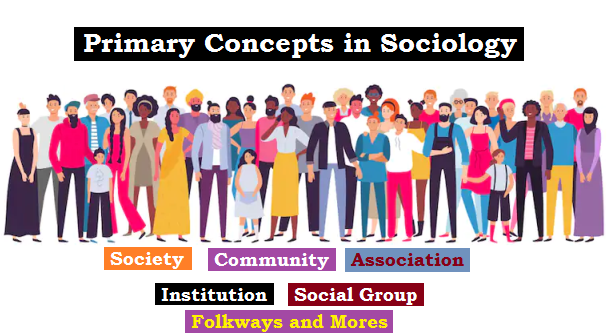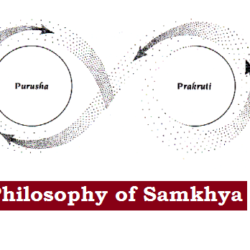
Society
The term society is most fundamental to sociology. It is derived from the Latin word socius which means companionship or friendship.
Society is a network based on social relationship between people.
Maclver defines society as a web of social relationship.
Characteristics of Society:
- Likeness: Likeness of members in a social group is the primary basis of their mutuality. Likeness is the one element which must have strongly stimulated the group feelings in bringing men, women and children together. Likeness is the link-up for mutuality.
- Social relations: Relationship makes possible the feeling of ‘we’.
- Differences: Sense of likeness in not always sufficient. Differences like diversity or variation viz. biological differences, division of labour, etc are very much part of the society. They differ from each other in respect of their interests, capacities, abilities and tendencies etc. These differences do not imply mutual conflict; instead; by it the organisation of society is further strengthened.
- Interdependence: It is not possible for human being to satisfy his desire in isolation. Society fulfills all the needs of the people.
- Cooperation: Without cooperation, no society can exist. If the members of the society do not work together for the common purposes, they cannot lead a happy and comfortable life.
- Competition: Struggle to get something limited
- Accommodation: Competing and conflicting individuals and groups adjust their relationships
- Assimilation: A person or group belonging to one culture adopts the practices of another, thereby becoming a member of that culture.
Types of Society:
- Mechanical: formed by solidarity of resemblance. i.e. simple division of labour
- Organic: formed by solidarity out of differences. i.e. complex division of labour
- Militant: formed by compulsory cooperation. i.e. individual for state welfare
- Industrial: formed by voluntary cooperation. i.e. state for individual welfare
- Folk: homogenous and traditionally organized
- Urban: heterogeneous and formalized system
Community
com= together
munis= to serve
Community is a group of people who interact with one another within a bounded geographic territory, often sharing common values, beliefs, or behaviors.
Basic Elements of Community:
- Group of people
- Geographical territory: Living together facilities people to develop social contacts, give protection, safety and security.
- Community sentiment: It implies ‘a feeling of belonging together. Community feeling has the four important aspects such as we-feeling, interdependence, participation and community control.
- Interaction among them: Interaction among the people of group
Community Vs Society
| Community | Society |
| 1. It is a group of people living together in a particular locality. | 1. Society has no definite boundary. It is universal and pervasive. |
| 2. It refers to human relationships that are highly personal, intimate and enduring. | 2. It refers to human relationships that are impersonal, superficial and transitory. |
| 3. The presence of sentiments among the members is necessary. | 3. There is element of likeness but not necessarily include people in oneness, enemies can also be included in a society. |
| 4. Community came much later than the society. | 4. The society has much wider scope as compared with the community. |
| 5. Cooperation and conflicts cannot co-exist in a community. | 5. Cooperation and conflicts are part of a society as likeness and differences exist together. |
| 6. Community is a part of society. E.g. Hindu Community, Parsi Community, etc. | 6. Society has many communities. E.g. Arya Samaj Society, Harijan Society, etc. |
Association
A group of people organized for the pursuit of common interest.
Characteristics of Association:
- Group of people
- Similar aim and objectives
- Thoughtful establishment
- Formal relationship
- Voluntary membership
Community Vs Association
| Community | Association |
| 1. It is a group of people living together in a particular locality. | 1. It is a thoughtful formation of people (artificial creation) |
| 2. It does not have any specific interests, but embraces all purposes. | 2. It is formed for the pursuit of specific interests. |
| 3. Membership of a community is compulsory. i.e. we are born in it. | 3. Membership is voluntary. i.e. we choose our associations. |
| 4. Community sentiment is essential feature. | 4. Community sentiment is not essential. |
| 5. It works through customs and traditions. | 5. It works through written code of conduct. |
Institution
It is an arrangement of integrated set of social norms organised around the preservation of basic social values.
Institutions can refer to mechanisms which govern the behavior of a set of individuals within a given community; moreover, institutions are identified with a social purpose.
Examples of institutions include: Family, Religion, Peer groups, Educational institutions, Military system, etc.
Characteristics of an Institution:
- Common cultural system: A cultural system exists and all follow the same cultural practices and traditions.
- Permanent recognition: The beliefs are laid out and tried and tested over time. It they sustain then they become the fundamental beliefs of the institution and gain a permanent recognition.
- Well-known defined objectives: The objectives resonate with the cultural norms.
- Transmitter of social heritage: It is in the institutions that individual learns basic values of the life. It helps to conserve and transmit social culture and heritage along generations.
- Resistant to social change: Social institutions are social patterns that establish the organized behaviour of human beings in the performance of basic social functions, therefore resistant to social change.
Community Vs Association
| Institution | Association |
| 1. Institutions are constituted of laws, rules and regulation. (social aspect) | 1. Associations are comprised of human beings. (human aspect) |
| 2. Institutions are abstract and have no form. | 2. Associations are concrete and have form. |
| 3. Institutions are primarily evolved. It grows naturally. | 3. Associations are formed out of necessity. |
| 4. Institutions are relatively more permanent. | 4. Associations are not as permanent as institutions. |
| 5. It has forced membership. | 5. It has voluntary membership. |
| 6. It is transferable in generations. | 6. Not transferable. |
Social Group
It is a group of people who interact with each other and share similar characteristics and a sense of unity.
Social Groups are dynamic in nature, though some internal changes keep occurring.
e.g. family, friendship, caste etc.
Characteristics of Social Group:
- Group of individuals
- Interaction among them
- Common goals and objectives
- Unity and solidarity
- Group norms and regulations
Types of Social Groups:
- Primary Group: small group, members share personal relationship (In- Group)
e.g. Family
- Secondary Group: large group, formal and institutional relationship (Out- Group)
e.g. NGOs, Political Party
Primary Group Vs Secondary Group
| Primary Group | Secondary Group |
| 1. Size of group is small | 1. Size of group is large. |
| 2. Members share direct, personal and informal relationship. | 2. Members share indirect, formal and institutional relationship. |
| 3. Social control through informal means- folkways, mores, etc. | 3. Social control through formal means- laws, code of conduct, etc. |
| 4. Its goal is to fulfill needs of its members. | 4. Its goal is to achieve specific objectives. |
| 5. Its structure is rigid, regulated by informal rules. | 5. Its structure is flexible, regulated by formal rules. |
| 6. Its membership is compulsory and permanent. | 6. Its membership is voluntary and temporary. |
Folkways and Mores
Folkways: Norms of society that come into effect to have similarities (rather conformity) in behaviour. They are unwritten and no penalties for their violation. They are learnt by observing others.
e.g. Dressing sense, Talking loud, etc.
Mores: Norms of society that have a formal way of ensuring their compliance. Violation of these attracts severe punishment of society. They focus greater importance of the welfare of the society.
e.g. Untouchability, Purdah system, Cow slaughter, etc.
Folkways Vs Mores
| Folkways | Mores |
| 1. They have informal ways of ensuring compliance. | 1. They have formal ways of ensuring compliance. |
| 2. They are unwritten, and there is no penalty for their violation. | 2. They are written in the form of laws and their violation attracts punishment. |
| 3. Folkways are of a more general and wider character than mores. | 3. Mores imply a value judgment about the folkways. |


 Home
Home Syllabus
Syllabus Contact Us
Contact Us




